1 Volumes
The Society of Friends
New volume 2019-05-23 17:20:54 description
Chapter Other Quaker Institute.
New topic 2018-07-18 17:48:16 description
Logan, Franklin, Library
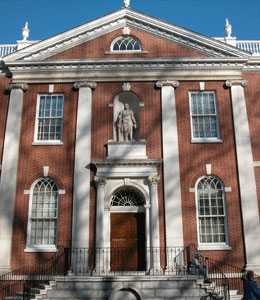
|
| The Library Company of Philadelphia |
Jim Greene is the librarian of the Library Company of Philadelphia, and one of the leading authorities on James Logan, the Penn Proprietors' chief agent in the Colony. Since Logan and Ben Franklin were the main forces in starting the oldest library in America, knowing all about Logan almost comes with the job of Librarian. We are greatly indebted to a speech the other night, given by Greene at the Franklin Inn, a hundred yards away from the Library.
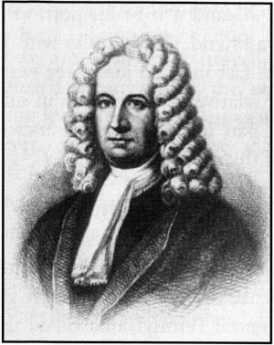
|
| James Logan |
Logan has been described as a crusty old codger, living in his mansion called Stenton and scarcely venturing forth in public. He was known as a fair dealer with the Indians, which was an essential part of William Penn's strategy for selling real estate in a land of peace and prosperity. Unfortunately, Logan was behind the infamous Walking Purchase, which damaged his otherwise considerable reputation. Logan must have been a lonesome person in the frontier days of Philadelphia because he owned the largest private library in North America and was passionate about reading and scholarly matters. When he acquired what was the first edition of Newton's Principia, he read it promptly and wrote a one-page summary. Comparatively few people could do this even today. It's pretty tough reading, and those who have read it would seldom claim to have "devoured" it.
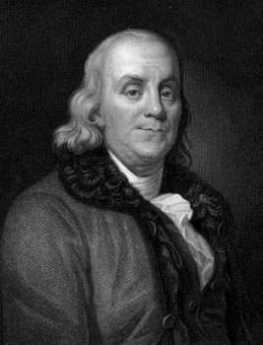
|
| Benjamin Franklin |
Except young Ben Franklin, who never went past second grade in school. The two became fast friends, often engaging in such games as constructing "Magic Squares" of numbers that added up to the same total in various ways. For example, Franklin doodled off a square with the numbers 52,61,4,13,20,29,36,45 (totaling 260) on the top horizontal row, and every vertical row beneath them totaling 260, as for example 52,14,53,11,55,9,50,16, while every horizontal row also totaled 260 as well. The four corner numbers, with the 4 middle numbers, also total 260. Logan constructed his share of similar games, which it is difficult to imagine anyone else in the colonies doing at the time.
Logan and Franklin together conceived the idea of a subscription library, which in time became the Library Company of Philadelphia in 1732. The subscription required of a library member was intended to be forfeited if the borrower failed to return a book. Later on, the public was allowed to borrow books, but only on deposit of enough money to replace the book if unreturned. We are not told whose idea was behind these arrangements, but they certainly sound like Franklin at work. More than a century later, the Philadelphia Free Library was organized under more trusting rules for borrowing which became possible as books became less expensive.
Logan died in 1751, the year Franklin at the age of 42 decided to retire from business -- and devote the remaining 42 years of his life to scholarly and public affairs. He first joined the Assembly at that time, so he and Logan were not forced into direct contention over politics, although they had their differences. How much influence Logan exerted over Franklin's plans and attitudes is not entirely clear; it must have been a great deal.
Fernery
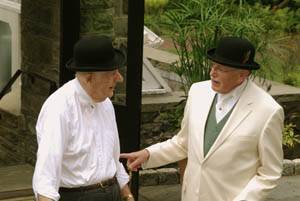
|
| Gardeners |
As explained by the curator of The Morris Arboretum, there are a few other ferneries in the world, but the Morris has the only Victorian fernery still in existence in North America. That doesn't count a few shops that sell ferns and call themselves ferneries; we're talking about the rich man's expensive hobby of collecting rare examples of the fern family in an elaborate structure. That's called a Victorian fernery. The one we have in our neighborhood is really pretty interesting; worth a trip to Chestnut Hill to see it.
Although our fernery was first built by the siblings John and Lydia Morris, it was rebuilt at truly substantial cost by the philanthropist Dorrance Hamilton. It is partly above ground as a sort of greenhouse, and partly below ground, with goldfish and bridges over its pond. Maintaining an even temperature is accomplished by a complicated arrangement of heating pipes. The temperature the gardener chooses affects both the heating bill and the species of fern that will thrive there. You could go for 90 degrees, but practical considerations led to the choice of 58 degrees. The prevailing humidity will affect whether the fern reproduction is sexual or asexual, a source of great excitement in 1840, but survivors of Haight-Asbury are often more complacent on the humidity point.
There are little ferns, big ferns, tree ferns, green ferns, and not-so-green ferns; the known extent of ferns runs to around five hundred species. Not all of them can be found in Chestnut Hill, what with humidity and all, but there are enough to make a very attractive and interesting display. For botanists, this is a must-see exhibit. For the rest of us, it's probably the only one of its kind we will ever see, a jewel in Philadelphia's crown, and shame on you if you pass it by.
Morris Arboretum
 The former estate of John and Lydia Morris is run as a public arboretum, one of the finest in North America. 
|
Morris is the commonest Philadelphia name in the Social Register, derived largely from two unrelated Colonial families. In addition to their city mansions, both families had country estates. The country estate once belonging to the Revolutionary banker Robert Morris was Lemon Hill, just next to the Art Museum, where Fairmount Park begins. But way up at the far end of the Park, beyond Chestnut Hill, was Compton, the summer house of John and his sister Lydia Morris. This Morris family had made a fortune in iron and steel manufacture and were firmly Quaker. Both John Morris and his sister were interested in botany and had evidently decided to leave Compton to the Philadelphia Museum of Art as a public arboretum. John died first, leaving final decisions to Lydia. As the story is now related, Lydia had a heated discussion with Fiske Kimball, at the end of which the Art Museum deal was off. She turned to her neighbor Thomas Sovereign Gates for advice, and the arboretum is now spoken of as the Morris Arboretum of the University of Pennsylvania. It is also the official arboretum of the State of Pennsylvania. To be precise, the Morris Arboretum is a free-standing trust administered by the University, with the effect that five trustees provide legal assurance that the property will be managed in a way the Morrises would have wished. In Quaker parlance, Lydia possessed "steely meekness."
A public arboretum is sort of an outdoor museum of trees, bushes, and flowers, with an indirect consequence that many museum visitors take home ideas for their own gardens. Local commercial nurseries tend to learn here what is popular and what grows well in the region, so there emerges an informal collective vision of what is fashionable, scalable, and growable, with the many gardeners in the region interacting in a huge botanical conversation. The Morris Arboretum and two or three others like it go a step further. There are two regions of the world, Anatolia and China-Korea-Japan, with much the same latitude and climate as the East Coast of America. Expeditions have gone back and forth between these regions for a century, transporting novel and particularly hardy or disease-resistant specimens. An especially useful feature is that Japan and parts of Korea were never covered with glaciers, hence have many species found nowhere else in the temperate zone. Hybrids are developed among similar species found on different continents, and variants are found which particularly attract or repel the insects characteristic of each region. The Morris Arboretum is thus at the center of a worldwide mixture of horticulture and stylish outdoor fashion, affecting millions of home gardeners who may never have heard of the place.
Tyler Arboretum
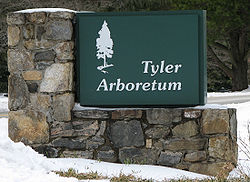
|
| Tyler Arboretum |
There are over thirty arboreta in the Philadelphia region, and one of the oldest and largest is located in Delaware County. The 650 acres of the Tyler Arboretum, adjoining 2500 acres of a state park, create a rather amazing wooded area quite close to heavily settled urban Philadelphia. The Arboretum is located on land directly deeded by William Penn, but it was privately held until 1940 and so is not as well known as several other arboreta of the region. The early Quakers, it may be recalled, often disapproved of music and "artwork", so their diversions tended to concentrate on various forms of natural science. The first director of the Tyler, Dr. John Wister, planted over 1500 azalea bushes as soon as he took office in the 1940s. They are now seventy or eighty years old, quite old and big enough to make an impressive display. Even flowering bushes seemed a little fancy to the original Quakers.
The interests of the earlier owners of the property were more focused on trees, especially conifers. The property contains several varieties of redwoods, including one impressive California redwood, said to be the largest east of the Mississippi. High above the ground, it splits into two main branches, the result of depredation by someone cutting the top off for a Christmas tree. So a large area near Painter Road is enclosed by a high iron fence, containing most of the conifer collection, and warding off the local white-tailed deer. Several colors of paint are to be seen high on many prominent trees, marking out several walking trails of varying levels of difficulty.
And then there are large plantings of milkweed, providing food for migrating butterflies; near a butterfly educational center. There are large wildflower patches and considerable recent flower plantings around the houses at the entrance. Because of the, well, Christmas tree problem, several houses on the property are still occupied.
The only serpentine barren in Delaware County is located on the property; we have described what that is all about in another essay. As you would imagine, there are great plant and flower auctions in the spring, conventions of butterfly and bird-watching groups at other times. The educational center is attracting large numbers of students of horticulture these days, and photographers. Flower gardens and photographers go together like Ike and Mike.
It's a great place for visitors, for members who are more involved, and for those with serious interests. With all that land to cover, some ardent walkers have enough ground to keep them regularly busy. Becoming a volunteer is a sign of serious interest, and that group is steadily growing. For a place that traces back to William Penn, it's slowly getting to be well known.
Friends Lifecare at Home
Over thirty Quaker retirement villages scatter through America, more than twenty in the suburbs of Philadelphia -- "under the care of the Yearly Meeting", as their expression has it. But for some people, community living seems unattractive. It does not speak to their condition.
For one thing, it may not be affordable.

|
| Friends Lifecare |
Or the style of may seem too fancy, or too plain, for some tastes regardless of cost. The increasing emotional rigidity of growing older is a factor; by the time people get to be seventy-five, they had better make this decision or forget it. Plenty of people are hale and hearty at ninety, but they establish pretty firm ideas about the sort of person they want for neighbors while they are still in the workforce. Quite often it's just a habit, people have lived in their home for several generations and cannot imagine another neighborhood, lifestyle, or environment. This is home, and they intend to die there.
So, to address this need, or market, a group of Quakers conceived of a retirement village without walls. Live in your own home and someone will come to oversee things, will know what to do if there is an emergency, and may eventually make the decision for you that you absolutely must go somewhere else. All of this is wrapped within an insurance vehicle, to recognize the fixed incomes of retired people, the inevitability of terminal illnesses, and the occasional risk of monumental medical expenses. At present, about 1600 people in Philadelphia are enrolled in the unique plan of Friends Lifecare at Home, making it one of the largest retirement communities in the country. The organization receives universal praise for its imaginative responses, as well as the dependability and high quality of the people it sends out to the homes of subscribers. Friends Lifecare is a pioneer, and it is gradually weeding out the ideas that didn't work and adding new features that were not originally contemplated. One of its greatest challenges is the need to adapt to unexpected and uncontrollable changes in the Medicare program. Slashes in the Medicare program could bankrupt Friends Lifecare, and even sudden windfalls like the Medicare Drug Benefit create management problems. There can be no doubt that one element of trust exists for which there is no substitute; Philadelphians know that the invisible support of the community and its Quaker core is behind them. If anyone can possibly preserve a moral commitment to the elderly, it will be the Quakers.
Ultimately, the commitment is not so much to 1600 subscribers as to the notion of finding out what works. Life expectancy has extended by three additional years, during the past ten; that's a joy, but it's a problem to finance. The optimum size of the organization is also an unsettled question. Although this program is relatively large by comparison with individual retirement villages, it may not be large enough to have spare capacity to cope with influenza epidemics or record-breaking spells of bad weather. Since it's the only one of its kind, it is vexed by the popularity in ever-widening geographic areas. It must grow to some reasonable size in one area before it can spread its resources to another. By the same reasoning, it must have a reasonable number of prosperous subscribers if it is to accept even a limited number of poor ones.
The idea of creating a seamless partnership with the residential-type retirement villages is certainly attractive, but Friends Lifecare must be careful to avoid becoming too much of a life raft for other people's problems. When the resale price of residential housing rises in a housing bubble, people wish to cling to a rising investment. During the same economic period, the entry and rental price of residential villages also rise. With a great many uncertainties that are specific to this pioneering effort, it is hard to know what policies to develop to insulate the lifecare environment from speculation in the mortgage and housing markets. Or, right now, high-rise apartment development. All of this creates a need for clear minds in the governance, determined to see and acknowledge difficult reality. If anyone can do it, Quakers can.
5 Blogs
Logan, Franklin, Library
 James Logan and Benjamin Franklin were at the opposite ends of the social scale in Colonial Philadelphia and were to adopt strongly differing political views. But each recognized the intellectual power of the other, and they were fast friends.
James Logan and Benjamin Franklin were at the opposite ends of the social scale in Colonial Philadelphia and were to adopt strongly differing political views. But each recognized the intellectual power of the other, and they were fast friends.
Fernery
 Around 1840, there was a brief worldwide craze for ferns, related to the exciting discovery of their complicated reproductive process. Only one Victorian fernery still exists in North America, at the Morris Arboretum in Philadelphia.
Around 1840, there was a brief worldwide craze for ferns, related to the exciting discovery of their complicated reproductive process. Only one Victorian fernery still exists in North America, at the Morris Arboretum in Philadelphia.
Morris Arboretum
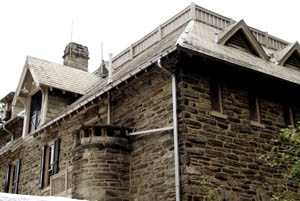 At the furthermost corner of Fairmount Park, the former estate of John and Lydia Morris is run as a public arboretum, one of the two or three finest in North America.
At the furthermost corner of Fairmount Park, the former estate of John and Lydia Morris is run as a public arboretum, one of the two or three finest in North America.
Tyler Arboretum
 A 650-acre Arboretum next to a 2500-acre state park makes for a lot of nature walks and bird watching, as well as a gazillion azaleas and tree specimens. The only serpentine barren in Delaware County is located there.
A 650-acre Arboretum next to a 2500-acre state park makes for a lot of nature walks and bird watching, as well as a gazillion azaleas and tree specimens. The only serpentine barren in Delaware County is located there.
Friends Lifecare at Home
 Philadelphia Quakers run over twenty retirement communities for the elderly in their region. One of them is a virtual village, one without walls.
Philadelphia Quakers run over twenty retirement communities for the elderly in their region. One of them is a virtual village, one without walls.